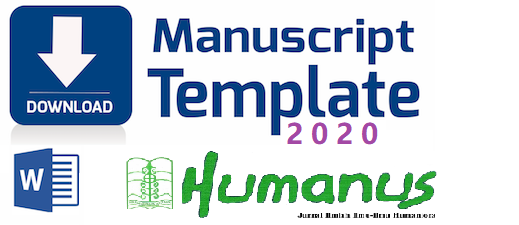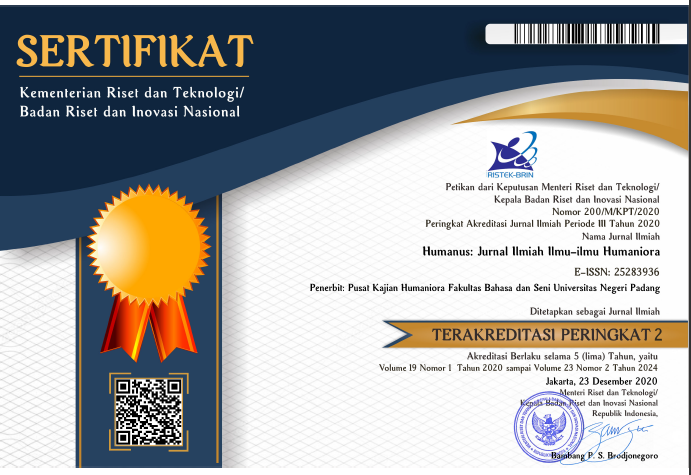Preschool-Aged Children’s Use of Directive Acts: A Case Study in Bina Buah Hati Preschool, Yogyakarta
 ),
), (1) Universitas Negeri Yogyakarta
 Corresponding Author
Corresponding Author
Copyright (c) 2023 Humanus
DOI : https://doi.org/10.24036/humanus.v22i1.118459
Full Text:
 Language : en
Language : en
Abstract
Keywords
References
Alston, W. P. (2000). Illocutionary Acts and Sentence Meaning. Cornell University Press.
Anjani, H. D., & Devi, S. (2019). Analisis tindak tutur direktif anak usia 4-5 tahun di TK Bustanul Athfal 3 Kota Makassar. Seminar Internasional Riksa Bahasa XIII, 395–406.
Arani, S. S. (2012). A study of directive speech acts used by iranian nursery school children: The impact of context on children’s linguistic choices. International Journal of Applied Linguistics and English Literature, 1(5), 163–175. https://doi.org/10.7575/ijalel.v.1n.5p.163
Austin, J. L. (1975). How to Do Things with Words. Oxford University Press.
Bruner, J. (1983). Child’s Talk Learning to Use Language. Oxford University Press.
Burchinal, M. R., Roberts, J. E., Riggins, R., Zeisel, S. A., Neebe, E., & Bryant, D. (2000). Relating quality of center-based child care to early cognitive and language development longitudinally. Child Development, 71(2), 339–357.
Cameron-Faulkner, T. (2014). Speech acts. In P. J. Brooks & V. Kempe (Eds.), Encyclopedia of Language Development (pp. 573–576). SAGE Publications, Inc.
Chejnová, P. (2015). Development of directives in child language: A case study of Czech. Topics in Linguistics, 15. https://doi.org/10.2478/topling-2015-0002
Clark, E. V., & Wong, A. D.-W. (2002). Pragmatic directions about language use: Offers of words and relations. Language in Society, 31(2), 181–212.
Collavin, E. (2011). Speech Acts. In W. Bublitz & N. R. Norrick (Eds.), Foundations of Pragmatics (pp. 373–396). Walter de Gruyter GmbH & Co. KG.
Creswell, W. J., & Creswell, J. D. (2018). Research Design: Qualitative, Quantitative adn Mixed Methods Approaches (5th ed.). SAGE Publications, Inc.
Cutting, J. (2002). Pragmatics and Discourse: A Resource Book for Students. Routledge.
Davies, D. (2011). Child Development: A Practitioner’s Guide (3rd ed.). The Guilford Press.
Del Río, P., & Álvarez, A. (2007). Inside and outside the zone of proximal development: an ecofunctional reading of Vygotsky. In H. Daniels, M. Cole, & J. V. Wertsch (Eds.), The Cambridge Companion to Vygotsky (pp. 276–303). Cambridge University Press.
Dickinson, D. K., & Porche, M. V. (2011). Relation between language experiences in preschool classrooms and children’s kindergarten and fourth-grade language and reading abilities. Child Development, 82(3), 870–886.
Fetzer, A. (2011). Pragmatics as a linguistic concept. In W. Bublitz & N. R. Norrick (Eds.), Foundations of Pragmatics (pp. 23–50). Walter de Gruyter GmbH & Co. KG.
Georgalidou, M. (2008). The contextual parameters of linguistic choice: Greek children’s preferences for the formation of directive speech acts. Journal of Pragmatics, 40, 72–94. https://doi.org/10.1016/j.pragma.2007.08.009
Gillen, J. (2003). The Language of Children. Routledge.
Gilly, M., & Roux, J.-P. (1993). Social routines, pragmatic schemas, and schemes in how children distribute objects between the ages of three and six. European Journal of Psychology of Education, 8(4), 403–421.
Gualmini, A. (2005). The Ups and Downs of Child Language: Experimental Studies on Children’s Knowledge of Entailment Relationships and Polarity Phenomena. Routledge.
Hoyte, F., Torr, J., & Degotardi, S. (2014). The language of friendship: Genre in the conversations of preschool children. Journal of Early Childhood Literacy, 12(1), 20–34. https://doi.org/10.1177/1476718X13492941
Hübscher, I., Wagner, L., & Prieto, P. (2020). Three-year-olds infer polite stance from intonation and facial cues. Journal of Politeness Research, 16(1), 85–110. https://doi.org/10.1515/pr-2017-0047
Keel, S. (2016). Socialization: Parent-Child Interaction in Everyday Life. Routledge.
Kissine, M. (2013). From Utterances to Speech Acts. Cambridge University Press.
Leavy, P. (2017). Research Design: Quantitative, Qualitative, Mixed Methods, Arts-Based, and Community-Based Participatory Research Approaches. The Guilford Press.
Leech, G. (1989). Principles of Pragmatics. Longman.
Mashburn, A. J., Justice, L. M., Downer, J. T., & Pianta, R. C. (2009). Peer effects on children’s language achievement during pre-kindergarten. Child Development, 80(3), 686–702.
Musfiroh, T. (2017). Psikolinguistik Edukasional: Psikolinguistik untuk Pendidikan Bahasa. Tiara Wacana.
Nadar, F. X. (2009). Pragmatik dan Penelitian Pragmatik. Graha Ilmu.
Owens, R. E. (2012). Language Development: An Introduction (8th ed.). Pearson Education, Inc.
Pentimonti, J. M., Justice, L. M., Yeomans-Maldonado, G., McGinty, A. S., Slocum, L., & O’Connell, A. (2017). Teachers’ use of high- and low-support scaffolding strategies to differentiate language instruction in high-risk/economically disadvantaged settings. Journal of Early Intervention, 39(2), 125–146. https://doi.org/10.1177/1053815117700865
Read, B. K., & Cherry, L. J. (1978). Preschool children’s production of directive forms. Discourse Processes, 1(3), 233–245. https://doi.org/10.1080/01638537809544438
Ryckebusch, C., & Marcos, H. (2004). Speech acts, social context and parent-toddler play between the ages of 1;5 and 2;3. Journal of Pragmatics, 36, 883–897. https://doi.org/10.1016/j.pragma.2003.10.019
Santrock, J. W. (2011). Child Development: An Introduction (13th ed.). McGraw-Hill.
Sbisà, M. (2002). Speech acts in context. Language and Communication, 22, 421–436.
Schegloff, E. A. (2007). Sequence Organization in Interaction: A Primer in Conversation Analysis. Cambridge University Press.
Sealey, A. (1999). “Don’t be cheeky”: Requests, directives and being a child. Journal of Socilolinguistics, 3(1), 24–40.
Searle, J. R. (1976). A classification of illocutionary acts. Language in Society, 5(1), 1–23.
Stiawati, E. (2012). Kompetensi tindak direktif anak usia prasekolah. Bahasa Dan Seni, 40(2), 216–235.
Sudartinah, T. (2022). Thematic Contents of Preschool- Aged Children ’ s Utterances as Media to Shape Their Understanding of the World. Register Journal, 15(02), 163–182. https://doi.org/10.18326/rgt.v15i2.163-182
Taguchi, N. (2012). Context, Individual Differences and Pragmatic Competence. Multilingual Matters.
Tsuji, H., & Doherty, M. J. (2014). Early development of metalinguistic awareness in Japanese: Evidence from pragmatic and phonological aspects of language. First Language, 34(3), 273–290. https://doi.org/10.1177/0142723714538003
Van der Veer, R. (2014). Lev Vygostsky. Bloomsbury Academin.
Wasik, B. A., & Iannone-Campbell, C. (2013). Developing vocabulary through purposeful, strategic conversations. The Reading Teacher, 66(4), 321–332.
Wijana, I. D. P. (1996). Dasar-dasar Pragmatik. Penerbit Andi.
Wijana, I. D. P. (2021). Dasar-dasar Pragmatik (Edisi Revi). TS Publishers.
Yuniarti. (2010). Kompetensi Tindak Tutur Direktif Anak Usia Prasekolah (Kajian pada Kelompok Bermain Anak Cerdas P2PNFI Regional II Semarang). Universitas Diponegoro.
 Article Metrics
Article Metrics
 Abstract Views : 198 times
Abstract Views : 198 times
 PDF Downloaded : 83 times
PDF Downloaded : 83 times
Refbacks
- There are currently no refbacks.
Copyright (c) 2023 Humanus

This work is licensed under a Creative Commons Attribution-NonCommercial 4.0 International License.










